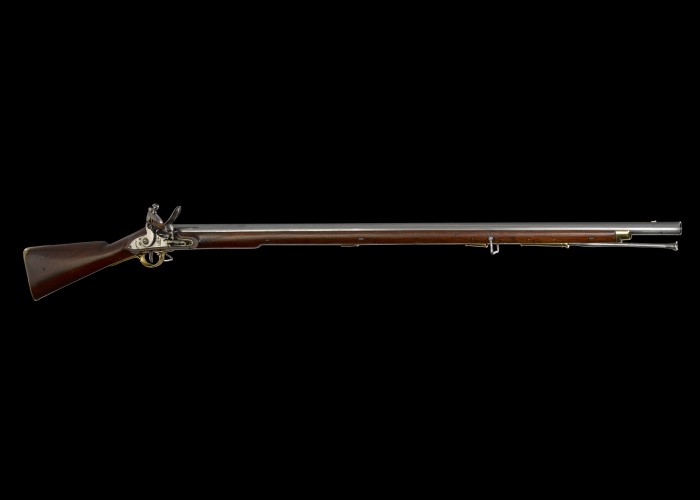Brown Bess Musket
This is an India Pattern musket, nicknamed the “Brown Bess”. This was the standard weapon for ordinary soldiers (other ranks) in the British infantry. About three million were made between 1793 and the end of 1815. It was the most common weapon that the British Army used in its 20 years of war against Revolutionary and Napoleonic France.
It is called the India Pattern because it was originally designed to arm the private army of the Honourable East India Company, which governed India until the Mutiny of 1857. It was very similar in form to an earlier type of musket known as the Short Land Pattern, which was in introduced in the early 1740s for cavalry soldiers known as dragoons.
The India Pattern was chosen because Britain needed to re-arm and this musket was cheaper and simpler to manufacture than the Land Pattern. It only had three ramrod pipes as opposed to four, there was no flat escutcheon plate on the stock and the side plate (the pieces which held the lock on) had no tail. The wood from which the stock was made was cheaper as well. Whilst this was normally walnut some emergency issue specimens were stocked in beech.
It had a 39-inch barrel that was three inches (~7.5cm) shorter than the Land Pattern and the cocks of the flintlock mechanisms were initially of swan-necked form. However, late in 1809 the stronger and more durable ring-necked style of cock was introduced.
The calibre was 1.9cm, making it the largest of all the muskets used at Waterloo. It could be loaded with captured enemy ammunition but enemy soldiers could not load their muskets with Brown Bess cartridges because the muskets balls were too big to fit in the barrels.
The name ‘Brown Bess’ dates from the late 18th century. The word ‘Bess’ might be a corruption of the German word Büchse, meaning musket, while ‘brown’ refers to the chemical finish applied to the barrel to reduce the likelihood of rusting.
A trained British soldier was expected to fire three shots a minute. Like most muskets the Brown Bess was not very accurate because the ball had to be quite loose for ease of loading. It would be very hard to hit another soldier by deliberately aiming at him at ranges greater than 100m.
This inherent lack off accuracy was compensated for by having a large number of men fire their muskets at the same time at very short range, sometimes less that 25m.
When the soldier’s musket was empty he relied on the bayonet, which had a sharp, triangular section blade of about 44cm. British bayonet charges were greatly feared by enemy troops. The soldiers were very keen to engage the enemy with their bayonets and often thought that they should be allowed to ‘give them the Brummagen’. (Brummagen is a slang name for Birmingham where many bayonets were made.)
-
Curatorial info
- Originating Museum: Royal Armouries
- Accession Number: 2014-3829
- Material: Walnut, steel
- Original record
-
Use this image
You can download a higher resolution image below, but please note the conditions of the licence.
- Rights Holder: Royal Armouries
- License Type: All Rights Reserved
Find it here
This object is in the collection of Royal Armouries









